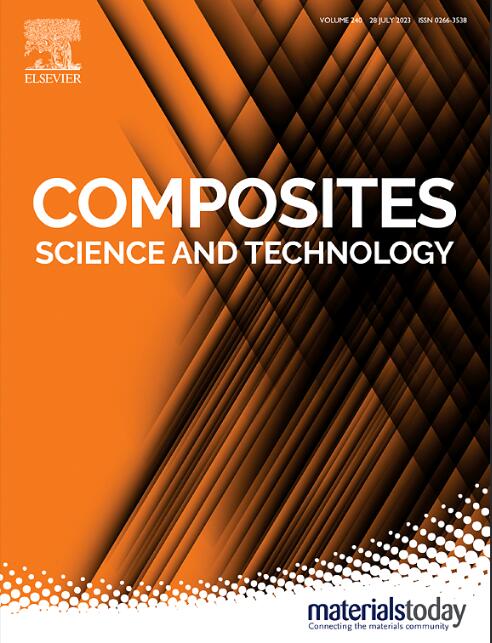一种设计高性能自修复聚硅氧烷-聚脲复合材料的新策略,该复合材料由多巴胺接枝纤维素纳米纤维和Zn2+增强
IF 8.3
1区 材料科学
Q1 MATERIALS SCIENCE, COMPOSITES
引用次数: 0
摘要
受天然贻贝的启发,一种新型的多巴胺接枝纤维素纳米纤维(DA-CNF)功能填料和Zn2+被掺入聚硅氧烷-聚脲中,以创建用于物联网应用的先进复合材料。通过实验表征、分子动力学(MD)模拟和有限元(FE)分析,我们深入研究了DA-CNF和Zn2+改善聚合物力学性能和自愈性能的机理。填料与基体之间额外添加的动态氢键和金属离子配位键的创新协同效应,同时提高了机械强度和自愈效率,克服了传统聚合物的权衡问题。结果表明,DA-CNF/PU@Zn2+的拉伸强度和愈合效率分别为对照样品的198.89%和104.77%。这一性能显著优于先前报道的自修复聚二甲基硅氧烷基材料。在物联网应用的电磁干扰屏蔽测试中,用DA-CNF/PU@Zn2+和银纳米线(AgNWs)制备的导电复合膜有效地解决了资源浪费和器件稳定性问题。这些发现为设计高性能自修复复合材料提供了一种新策略,在电子、航空航天、汽车和可穿戴设备方面具有巨大的应用潜力。本文章由计算机程序翻译,如有差异,请以英文原文为准。

A novel strategy for designing high-performance self-healing polysiloxane-polyurea composites enhanced by dopamine-grafted cellulose nanofibers and Zn2+
Inspired by natural mussels, a novel dopamine-grafted cellulose nanofiber (DA-CNF) functional filler and Zn2+ were incorporated into polysiloxane-polyurea to create advanced composites for Internet of Things applications. Through experimental characterization, molecular dynamics (MD) simulations and finite element (FE) analysis, we thoroughly investigated the mechanism by which DA-CNF and Zn2+ improve the mechanical and self-healing properties of the polymer. The innovative synergistic effect of extra-added dynamic hydrogen bonds and metal ion coordination bonds between the filler and matrix simultaneously enhanced mechanical strength and self-healing efficiency, overcoming the traditional trade-off problem in conventional polymers. The results showed that the tensile strength and healing efficiency of DA-CNF/PU@Zn2+ were 198.89 % and 104.77 % of the value of the control sample, respectively. This performance significantly surpasses that of previously reported self-healing polydimethylsiloxane-based materials. In the EMI shielding tests for Internet of Things applications, the conductive composite film fabricated with DA-CNF/PU@Zn2+ and silver nanowires (AgNWs) effectively addresses the issues of resource waste and device stability. These findings offer a new strategy for designing high-performance self-healing composite materials with significant potential for applications in electronics, aerospace, automotive and wearable devices.
求助全文
通过发布文献求助,成功后即可免费获取论文全文。
去求助
来源期刊

Composites Science and Technology
工程技术-材料科学:复合
CiteScore
16.20
自引率
9.90%
发文量
611
审稿时长
33 days
期刊介绍:
Composites Science and Technology publishes refereed original articles on the fundamental and applied science of engineering composites. The focus of this journal is on polymeric matrix composites with reinforcements/fillers ranging from nano- to macro-scale. CSTE encourages manuscripts reporting unique, innovative contributions to the physics, chemistry, materials science and applied mechanics aspects of advanced composites.
Besides traditional fiber reinforced composites, novel composites with significant potential for engineering applications are encouraged.
 求助内容:
求助内容: 应助结果提醒方式:
应助结果提醒方式:


